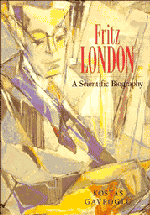Book contents
- Frontmatter
- Contents
- Preface
- Acknowledgements
- 1 From philosophy to physics
- 2 The years in Berlin and the beginnings of quantum chemistry
- 3 Oxford and superconductivity
- 4 Paris and superfluidity
- 5 Tying up loose ends: London in the USA
- Afterword: background leading to the microscopic theory of superconductivity by John Bardeen
- Publications by Fritz London
- Bibliography
- Index
3 - Oxford and superconductivity
Published online by Cambridge University Press: 12 January 2010
- Frontmatter
- Contents
- Preface
- Acknowledgements
- 1 From philosophy to physics
- 2 The years in Berlin and the beginnings of quantum chemistry
- 3 Oxford and superconductivity
- 4 Paris and superfluidity
- 5 Tying up loose ends: London in the USA
- Afterword: background leading to the microscopic theory of superconductivity by John Bardeen
- Publications by Fritz London
- Bibliography
- Index
Summary
Like the great majority of Jews living in Germany, Fritz and Edith London did not read the signs of the ominous events that culminated with the formation of the Nazi Government in 1933 and the decrees it issued during its first six months in power. London was obliged to resign and soon afterwards Lindemann offered him a research fellowship at Oxford University, UK.
Lindemann was very keen to set up a group to study low temperature physics. He had brought Simon, Mendelssohn and Kurti to Oxford, and, in 1934, London's brother Heinz joined them. A couple of months after Heinz's arrival, the two brothers worked out the electrodynamics of the superconductors and offered a theoretical schema for the explanation of superconductivity – twenty-two years after the phenomenon was first discovered. In 1933, Meissner and Ochsenfeld discovered that, in contrast to all expectations, superconductors were diamagnetic. In view of this result, the Londons considered the expulsion of the magnetic field, rather than the infinite conductivity, to be the fundamental characteristic of superconductors and proceeded to formulate their equations. Hence, the vantage point for superconductivity shifted and what was considered, for over twenty years, to be a phenomenon of infinite conductivity came to be regarded, primarily, as a case of diamagnetism at very low temperatures. Their theory was not a microscopic theory but explained the phenomenon in terms of the dynamics of the electrons. Even though the scientific community reacted favorably to their theory, Max von Laue had many objections to it.
- Type
- Chapter
- Information
- Fritz LondonA Scientific Biography, pp. 96 - 138Publisher: Cambridge University PressPrint publication year: 1995



